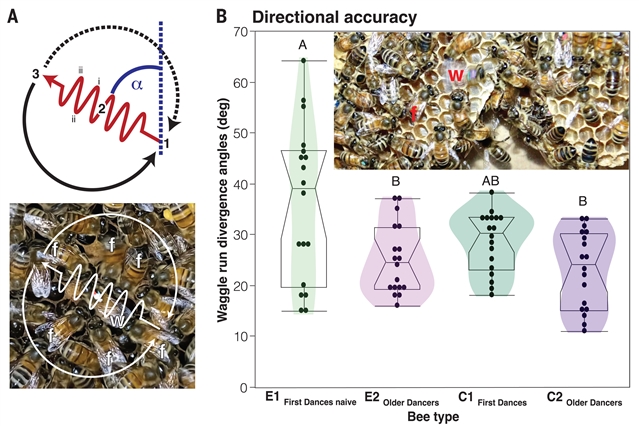
研究人员发现,正确的摇摆舞需要社会学习。在第一次跳舞前没有机会跟随任何舞蹈的蜜蜂产生了明显更多的无序舞蹈,其摇摆角度分歧误差较大,并且对距离的编码也不正确。前者的缺陷随着经验的增加而改善,但距离编码则是终身不变的。能够跟随其他舞者的蜜蜂的第一支舞蹈没有显示出缺陷。因此,社会学习塑造了蜜蜂的信号,正如它在人类婴儿、鸟类和其他多种脊椎动物物种中的通信一样。
据悉,蜜蜂使用一种复杂的空间指示交流形式。它们的“摇摆舞”通过将天体线索、视网膜光流和相对食物价值编码为巢内的运动和声音,向巢友传达资源的方向、距离和质量。。
附:英文原文
Title: Social signal learning of the waggle dance in honey bees
Author: Shihao Dong, Tao Lin, James C. Nieh, Ken Tan
Issue&Volume: 2023-03-10
Abstract: Honey bees use a complex form of spatial referential communication. Their “waggle dance” communicates the direction, distance, and quality of a resource to nestmates by encoding celestial cues, retinal optic flow, and relative food value into motion and sound within the nest. We show that correct waggle dancing requires social learning. Bees without the opportunity to follow any dances before they first danced produced significantly more disordered dances with larger waggle angle divergence errors and encoded distance incorrectly. The former deficit improved with experience, but distance encoding was set for life. The first dances of bees that could follow other dancers showed neither impairment. Social learning, therefore, shapes honey bee signaling, as it does communication in human infants, birds, and multiple other vertebrate species.
DOI: ade1702
Source: https://www.science.org/doi/10.1126/science.ade1702
